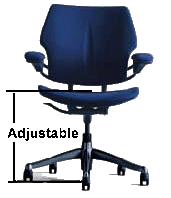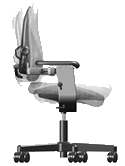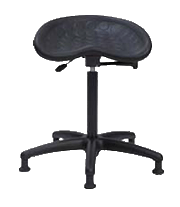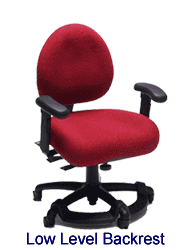|
Seat Height and Slope
Seat Depth and Width
Contouring and
Cushioning
Seat Back Parameters
Low enough to avoid
excessive pressure on the underside of the thigh
5th percentile of
popliteal height, male - 39 cm, female - 36 cm
¡@
 Adjustable Seats Adjustable Seats
-ƒnshould accommodate the 5th percentile female to the 95th
percentile male
-ƒnANSI recommendation: minimum range of 40.6 to 52 cm based on a
compressed seat (loaded with 45.4 kg)
¡@
¡@
¡@
 Seat Slope Seat Slope
Forward-tilting seat pan can lead to biomechanical advantages, and
is most beneficial when used with a slanted work surface.
Adjustable seats should permit some degree of forward tilt as well as a
slight backward tilt.
ANSI recommends seat pan angle of 0¢X to 10¢X
backward tilt.
Other researchers recommend 5¢X to 15¢X forward tilt and 5¢X backward tilt.
¡@
Seat Depth and Width
ƒnDepend on the type of seat being considered
Too Large Seat Depth
- Blood Circulation to Legs and Feet.
- Compression of the tissues causes irritation and discomfort.
- Blood clotting or thrombophlebitis (Inflammation of a vein caused by
or associated with the formation of a blood clot)
Too Shallow a Seat Depth
- the user has the sensation of falling off the front of the chair.
- result in a lack of support of the lower thighs.
¡@
 Contouring Contouring
When the human body is seated, the primary weight of the body can
best be supported by the ischial tuberosities (sitting bones) of the
buttocks.
However, seats should provide for a distribution of the weight over the
entire buttocks, with the pressure decreasing from these bones to the
periphery of the buttocks, which can be achieved by the use of contoured
seats.
¡@
Cushioning
The density and thickness of the seat-pan cushion affects pressure
distribution.
General recommendation: seat cushion thickness range from 4 to 5 cm
ƒn
Seat Back
Parameters
Low Level Backrest
For support to the lumbar region only.
Commence at a level which clears the major protuberance of the buttocks.
 Have its maximum prominence in the mid-lumbar region. Have its maximum prominence in the mid-lumbar region.
Conclude below the level of the shoulder blades to allow maximum freedom
of movement for the shoulders and arms.
The seat to maximum convexity is about 200mm.
Medium Level Backrest
For full shoulder support a backrest height of 550-600mm is required
for the 95th %ile man.
Such a backrest should have a forward convexity in the lumbar region
which gently merges into a plane surface or concavity in the upper part.
An excessively curved backrest is worse than one which is flat.
High Level Backrest
Full support of the head and neck requires a backrest height
1000-1100mm for the 95th %ile man.
|








